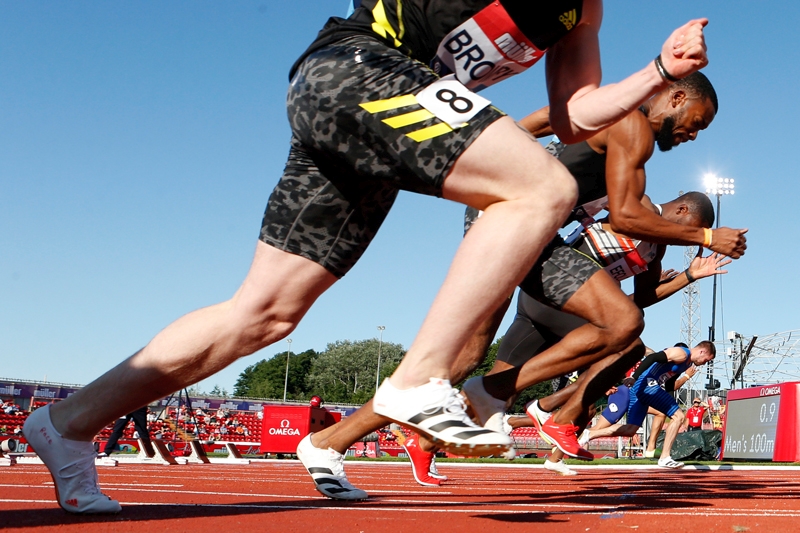Grit Gets the Glory, But Restraint Wins the Day
July 17, 2025
 Athletics - Diamond League - Gateshead International Stadium, Gateshead, Britain - July 13, 2021 Britain's Oliver Bromby in action at the start of the men's 100m b final Action Images via Reuters/Craig Brough
Athletics - Diamond League - Gateshead International Stadium, Gateshead, Britain - July 13, 2021 Britain's Oliver Bromby in action at the start of the men's 100m b final Action Images via Reuters/Craig Brough
Success in endurance sports requires balance. You need the grit to do the work and the restraint to avoid overdoing it.
Endurance sport athletes love grit stories. Julie Moss, for example, famously crawled over the finish line of the 1982 Ironman. This was televised live. The marathon comes from a Greek legend. A messenger ran so fast he died delivering a message. He died after delivering his message. Or the endless examples of masochism found in ultrarunning, cycling, and other niche endurance sports.
Grit may be sexy — the kind of story that gets headlines and adrenaline going. But it’s the quieter, unglamorous discipline of restraint that separates champions from burnout.
It’s like the excitement of making big decisions. In racing or at Woo Casino, knowing when to go for it or hold back can change your chances of winning. Endurance, like strategy, isn’t about going hard — it’s about going smart.
Endurance Athletes Love Celebrating Grit
When an athlete stands out to me, it’s usually because of one of two qualities. Neither reason relates to performance. The first is grit. An endurance athlete needs grit to succeed. No athlete possesses all the talents necessary to dominate their sport. And so, when I see grit in an athlete I’m working with, it gets me fired up.
But Restraint Is What Makes Champions
Restraint can mean different things. In this case, I’m referring to self-restraint. Psychologist Stephen Schroeder defined self-restraint as the ability to manage your impulses, emotions, or urges.” This kind of restraint is invaluable in endurance sports. It’s more useful than many athletes realize.
Why? It starts with motivation. To perform at their best, endurance athletes need a deep well of motivation. They must be willing to crawl. In endurance sports, you can’t be too motivated — but motivation by itself isn’t enough. When someone ends up crawling to the finish, it often reveals a lack of judgment as much as a lack of drive. They likely pushed beyond what was wise. They let their excitement get the better of them and made a poor pacing choice. They ended up crawling, completely spent.
The problem is, even if they know they need to try to temper their excitement, they don’t do it. Knowing they need to make the call and making it are two different things. Athletes need to put their judgment into action if they want to have a real impact. But using good judgment doesn’t happen on its own.
Restraint is like a guide for athletes. It helps them follow their better judgment and control their motivation when needed. Restraint may not be the most thrilling trait in sports, but it is crucial. It’s as essential as motivation and judgment for success in any athletic endeavor. I’m always impressed when I see an athlete I’m coaching show this quality.
Restraint as a Predictor of Success
Endurance mastery isn’t about pushing harder — it’s about training smarter. It’s about knowing when to hold back. Grit earns applause, but it’s restraint that sustains greatness over time. This is true across more than 100 athletes from different sports.
Athletes who know how to hold back usually excel in their sport.
Take the First Step, Then Keep Showing Up
Initiatory control is the standard type of self-control. Athletes and coaches value it highly. A study of 398 teens and young adults training for a marathon showed some interesting results. Those who had firm control to start their runs, even when they didn’t want to, did better on race day. But those whose initiatory control weakened during training did worse.
Be a Master of Restraint
I’ve spent time with elite endurance athletes. One thing stands out: they excel at restraint. Elite athletes focus on hitting their goals accurately. They’re skilled at recognizing when to go hard and when to pull back. Many non-elite athletes often overdo it. Instead of pacing themselves, they usually chase faster times or push through tough sessions. If a session isn’t going well or they feel pain, they don’t push through. Instead, they adjust to stay healthy and consistent.
This mindset applies not only to individual workouts but also to long-term training. Jakob Ingebrigtsen, a top middle-distance runner, tracks his intensity. He uses blood lactate tests and treadmill sessions to do this. The real key to his success isn’t the data. It’s the philosophy behind it. No session should be so tough that it risks injury or ruins the next one. His steady, measured approach is a model of how restraint builds greatness over time.
Final Thoughts
In the end, true mastery in endurance sports isn’t about who pushes the hardest, but who holds back the smartest. Grit may get the spotlight, but it’s restraint that leads to lasting success. Champions aren’t tough — they’re tactical.
January 6, 2026
The Social Architecture of Online Casinos: How They've Become Unexpected Virtual Community Spaces for Slovenian Players
Slovenia has witnessed a remarkable transformation in how people perceive and use online casino platforms over the past decade The modern online casino experience extends far beyond individual Read MoreDecember 16, 2025
Gamification in the iGaming Sector: explanation by casino online Millioner
Many casinos face player retention challenges Casinos are looking for clever ways to attract users without relying on large bonuses or flashy advertising Modern sites like casino online Millioner: Read MoreDecember 16, 2025


Tell Us What You Think Below